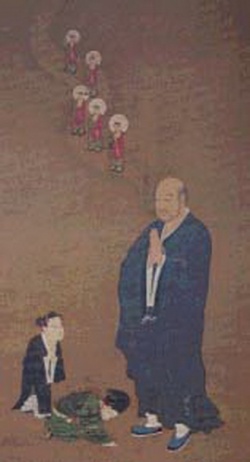Shan-tao
Shan-tao (Jp. Zendo) [613-681]
Shan-tao is the Chinese patriarch on whom Honen relied for most of his teaching in the Senchakushu.
In 641, he visited Tao-ch'o at Hsuan-chung-ssu temple and heard him give a lecture on the Meditation Sutra (Kuan wu-liang-shou ching), which greatly deepened his faith in the Pure Land.
Thereafter he went to Ch'ang-an where he disseminated the practice of calling upon the name of Amida Buddha. Shan-tao wrote five works on Pure Land teachings: the Kuan wu-liang-shou ching shu (Commentary on the Meditation Sutra), the Kuan-nien-fa-men (Dharma Gateway of Contemplation), the Wang-sheng-li-tsan (Hymns in Praise of Birth), the Fa-shih-tsan (Liturgical Hymns), and the Pan-chou-tsan (Hymns for Samadhi Wherein All the Buddhas are Present), which, except for the last one, are widely cited in the Senchakushu by Honen.
Shan-tao is generally credited for popularizing the nembutsu as the reciting of Amida's name rather than the visualization of him in his Pure Land.
Shan-tao (Chinese: 善導大師; pinyin: shàn dào dà shī; Japanese: Zendō) (613-681) was an influential writer for the Pure Land school of Buddhism, prominent in China, Korea, Vietnam and Japan. His writings had a strong influence on later Pure Land masters including Hōnen and Shinran in Japan.
In Jodo Shinshu Buddhism, he is considered the Fifth Patriarch.
Biography
Shan-tao was born at Tzu-jou in the present Anhui Province.
When he was young, he entered the priesthood and devoted himself to the study of the Larger Sutra of Immeasurable Life and the Vimalakirti Sutra.
One day, in the year 641, he visited the temple of the famous Pure Land master, Tao-cho, who happened to be giving a lecture on the Contemplation Sutra.
This lecture ultimately inspired him to follow, and then spread the Pure Land Teachings.
Shan-tao dwelt at the monastery of Xiangji Temple (Chinese: 香积寺; pinyin: xiāng jī sì) in Shaanxi, which continues to honor his memory and contributions. In his lifetime, Shan-tao wrote five major works on Pure Land Buddhism, with his commentaries on the Contemplation Sutra being among the most influential.
Teachings
Shan-tao was one of the first to propose that salvation through Amitabha Buddha could be achieved simply through his name. The practice known as the nianfo as a way of singular devotion to Amitabha Buddha was all that was needed.
In one of his more famous writings, Shan-tao spoke at great length about how simply saying the name of Amitabha Buddha was sufficient for salvation.
Centuries later, Shan-tao's writings would have a strong impact on Hōnen and the Pure Land Buddhist movement in Japan, particularly the Commentaries on the Contemplation Sutra (Chinese: 觀經四帖疏; pinyin: Guān jīng sì tiè shū; Wade–Giles: Kuan-wu-liang-shou-fo-ching-shu), particularly this statement:
“ "Only repeat the name of Amitabha with all your heart. Whether walking or standing, sitting or lying, never cease the practice of it even for a moment. This is the very work which unfailingly issues in salvation, for it is in accordance with the Original Vow of that Buddha." ”
Prior to this, Amitabha was incorporated into wider practices such as those found in the Tien Tai school of Buddhism, as part of complex and often difficult practices. Shan-tao often used imagery such as the "Light and Name of Amitabha" which "embraces" all beings. Ultimately, such writings marked a change in the way Buddhists viewed salvation through Amitabha.
The Three Minds and Four Modes of Practice
Among Shan-tao's teachings are the Three Minds and Four Modes of Practice for Pure Land Buddhism. In the Commentaries, sincere devotion to Amitabha Buddha over the long-term leads to three minds, or states of mind:
The Utterly Sincere Mind
The Profound, or Deeply Believing, Mind
The Mind which dedicates one's merit (or good works) toward rebirth in the Pure Land.
In Hymns in Praise ofBirth (Wang-sheng-li-tsan ), Shan-Tao taught the Four Modes of Practice that develop through devotion to Amitabha Buddha:
Reverence shown to Amida Buddha and bodhisattvas in the Pure Land: Avalokitesvara and Mahasthamaprapta.
Wholehearted and exclusive practice of reciting Amitabha's name.
Uninterrupted, as in routine, practice.
Long-term practice.
Shan-tao (613-681) was the fifth of the seven patriarchs in the tradition of Jodoshinshu and also the third of the five Pure Land masters in China.
His contribution to the development of Pure Land Buddhism was so great and far-reaching that it would be impossible to speak of the growth and spread of this form of Buddhism in China and its neighboring countries, including Japan, without reference to him.
Shan-tao's Liturgy for Birth - Ojoraisan - is a collection of passages and hymns from Pure Land sutras and discourses, arranged in six sections according to the six different times of the day. This is a formula of daily devotional practice.
Each section consists of a quotation from a canonical source, words of praise of Amida's virtues, a number of worshipful prostrations, and confession of Shan-tao's own karmic evil.

